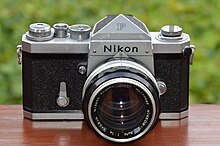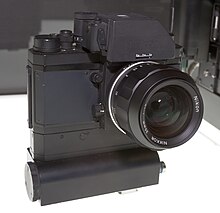
A single-lens reflex camera (SLR) is a camera that typically uses a mirror and prism system that permits the photographer to view through the lens and see exactly what will be captured. With twin lens reflex and rangefinder cameras, the viewed image could be significantly different from the final image. When the shutter button is pressed on most SLRs, the mirror flips out of the light path, allowing light to pass through to the light receptor and the image to be captured.

The Nikon FM is a mechanically operated, interchangeable lens, 35 mm film, single-lens reflex (SLR) camera. It was manufactured in Japan between 1977 and 1982 by Nippon Kogaku K. K..
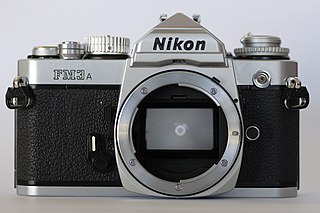
The Nikon FM3ᴀ is an interchangeable-lens, focal-plane shutter, 35 mm film, single-lens reflex (SLR) camera. It was manufactured by Nikon Corporation in Japan, on small-volume assembly lines, from 2001 to 2006. The camera was available in two colours: all black and satin chrome. The introductory US list price for the chrome body only was $820.

The Nikon FA is an advanced amateur-level, interchangeable lens, 35 mm film, single-lens reflex (SLR) camera. It was manufactured by the Japanese optics company Nippon Kogaku K. K. in Japan from 1983 to 1987. The FA used a titanium-bladed, vertical-travel Nikon-designed, Copal-made focal plane shutter with a speed range of 1 to 1/4000th second plus Bulb and flash X-sync of 1/250th second. It was available in two colors: black with chrome trim and all black. The introductory US list price for the chrome body only was $646. Note that SLRs usually sold for 30 to 40 percent below list price.

The Nikon FE2 is a 35 mm single lens reflex (SLR) camera manufactured by Nippon Kogaku K. K. in Japan from 1983 to 1987. The FE2 uses a Nikon-designed vertical-travel focal-plane shutter with a speed range of 8 to 1/4000th second, plus Bulb and flash X-sync of 1/250th second. It was available in two colors: black with chrome trim and all black. The introductory US list price for the chrome body only was $446. Note that SLRs usually sold for 30 to 40 percent below list price.

The Nikon FE is an advanced semi-professional level, interchangeable lens, 35 mm film, single-lens reflex (SLR) camera. It was manufactured by Nikon in Japan from 1978 to 1983, and was available new from dealer stock until c. 1984. The FE uses a metal-bladed, vertical-travel focal plane shutter with a speed range of 8 to 1/1000 second, plus Bulb, and flash X-sync of 1/125th second. It had dimensions of 89.5 millimetres (3.52 in) height, 142 mm (5.6 in) width, 57.5 mm (2.26 in) depth and 590 grams (21 oz) weight. It was available in two colors: black with chrome trim and all black. As on the FM, its model designation did not appear on the front of the camera, but was engraved as a small "FE" preceding the serial number on the rear of the housing.
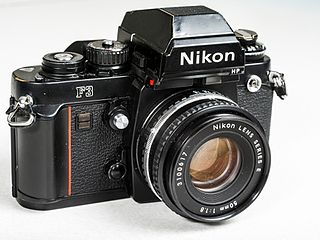
The Nikon F3 was Nikon's third professional single-lens reflex camera body, preceded by the F and F2. Introduced in March 1980, it had manual and semi-automatic exposure control whereby the camera would select the correct shutter speed. The Nikon F3 series cameras had the most model variations of any Nikon F camera. It was also the first of numerous Nikon F-series cameras to be styled by Italian designer Giorgetto Giugiaro, and to include a red stripe on the handgrip – a feature that would later become a signature feature of many Nikon cameras.

The Nikon FG is an interchangeable lens, 35 mm film, single-lens reflex (SLR) camera. It was manufactured by Nippon Kogaku K. K. in Japan from 1982 to 1986.

The Nikon F-mount is a type of interchangeable lens mount developed by Nikon for its 35mm format single-lens reflex cameras. The F-mount was first introduced on the Nikon F camera in 1959, and features a three-lug bayonet mount with a 44 mm throat and a flange to focal plane distance of 46.5 mm. The company continues, with the 2020 D6 model, to use variations of the same lens mount specification for its film and digital SLR cameras.
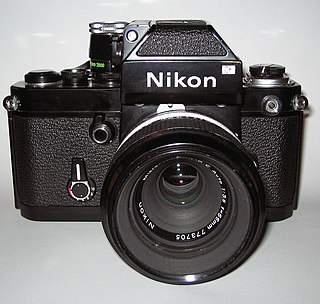
The Nikon F2 is a professional-level, interchangeable lens, 35 mm film, single-lens reflex (SLR) camera. It was manufactured by the Japanese optics company Nippon Kogaku K. K. in Japan from September 1971 to 1980. It used a horizontal-travel focal plane shutter with titanium shutter curtains and a speed range of 1 to 1/2000 second plus Bulb and Time, and flash X-sync of 1/80 second. It had dimensions of 98 mm height, 152.5 mm width, 65 mm depth and 730 g weight. It was available in two colors: black with chrome trim and all black. The F2 was adopted by both casual photographers and professional photographers, the latter of those especially photojournalists covering the later half of the Vietnam War.

The history of the single-lens reflex camera (SLR) begins with the use of a reflex mirror in a camera obscura described in 1676, but it took a long time for the design to succeed for photographic cameras. The first patent was granted in 1861, and the first cameras were produced in 1884, but while elegantly simple in concept, they were very complex in practice. One by one these complexities were overcome as optical and mechanical technology advanced, and in the 1960s the SLR camera became the preferred design for many high-end camera formats.

Nikkormat was a brand of cameras produced by the Japanese optics company Nippon Kogaku K. K., as a consumer version of the professional Nikon brand. Nikkormat cameras, produced from 1965 until 1978, were simpler and more affordable than Nikon-branded cameras, but accepted the same lenses as the Nikon F series cameras.
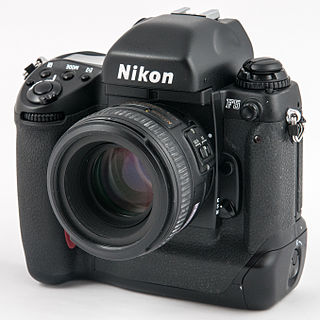
The Nikon F5 is a professional 35 mm film-based single-lens reflex camera body manufactured by Nikon from 1996 through 2004. It was the fifth in Nikon's professional film camera line, which began in 1959 with the Nikon F. It followed the Nikon F4 of 1988, which introduced in-body autofocus to Nikon's professional line. The F5 was in turn succeeded by the Nikon F6, as well as Nikon's parallel range of professional digital SLRs, beginning with the Nikon D1.

The Nikon FM10 is a manual focus 35 mm film camera formerly sold by Nikon Corporation. It is of SLR design and was first available in 1995. It is normally sold in a kit that includes a Zoom Nikkor 35–70 mm f/3.5-4.8 zoom lens, although a Zoom Nikkor 70–210 mm f/4.5-5.6 zoom lens is also available. An electronic companion model known as the FE10 was also sold at one stage.

The Nikkorex nameplate was used for a series of 35 mm film, single-lens reflex cameras sold by Japanese optical manufacturer Nippon Kogaku K.K., as well as a series movie cameras and movie projectors. The models, made by other companies, were designed and marketed as low-cost, feature-reduced equipment for the consumer market.
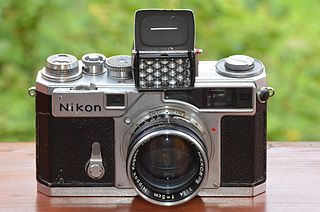
The Nikon SP is a professional level, interchangeable lens, 35 mm film, rangefinder camera introduced in 1957. It is the culmination of Nikon's rangefinder development which started in 1948 with the Nikon I, and was "arguably the most advanced rangefinder of its time." It was manufactured by the Japanese optics company Nippon Kogaku K. K.. Three other lower featured rangefinder models were subsequently produced on the SP frame, and production continued into the 1960s, but further development of Nikon's professional rangefinders ended with the introduction and success of the single lens reflex Nikon F in 1959.

The Auto-Reflex and Autoreflex is a series of 35mm SLR cameras made by Konica from 1965 to 1988. All these models have the Konica AR bayonet.
This article discusses the cameras – mainly 35 mm SLRs – manufactured by Pentax Ricoh Imaging Corp. and its predecessors, Pentax Corporation and Asahi Optical Co., Ltd.. Pentax must not be confused with Pentax 6x7 or Pentax 67 which are 120 medium format 6x7cm film cameras.

The Topcon RE Super, or Beseler Topcon Super D in USA, was launched by Tokyo Kogaku KK in 1963 and manufactured until 1971, at which point it was upgraded to the Super D and again to Super DM the following year. General sale continued for several years. These later models have a shutter release lock lever on the shutter release collar. It is a professional oriented 35mm SLR camera that had a comprehensive range of accessories available. It has a removable pentaprism viewfinder and focusing screen. It features the Exakta bayonet lens mount for interchangeable lenses. A special accessory shoe is situated at the base of the rewind knob with a standard PC sync. contact next to it. The release button is placed at the right-hand camera front, but there is no mirror-up facility; this was included on the upgraded versions. The standard lens is the RE. Auto-Topcor 1:1.4 f=5.8cm or the slightly slower 1:1.8 version. A battery-operated winder could be attached to the camera base.

The Leicaflex series of high-end single-lens reflex 35 mm format film cameras were introduced by Leitz Camera in 1964. The first camera body was paired with the new R bayonet series of lenses. Three model of the cameras were sold by Leitz; the Leicaflex Standard, the Leicaflex SL and the Leicaflex SL2.

